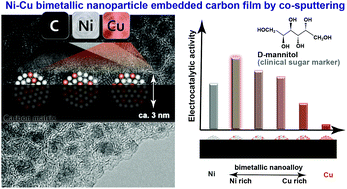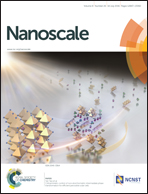Co-sputter deposited nickel–copper bimetallic nanoalloy embedded carbon films for electrocatalytic biomarker detection†
Abstract
We report the fabrication of a nickel (Ni)–copper (Cu) bimetallic nanoalloy (∼3 nm) embedded carbon film electrode with the unbalanced magnetron (UBM) co-sputtering technique, which requires only a one-step process at room temperature. Most of each nanoalloy body was firmly embedded in a chemically stable carbon matrix with an atomically flat surface (Ra: 0.21 nm), suppressing the aggregation and/or detachment of the nanoalloy from the electrode surface. The nanoalloy size and composition can be controlled simply by individually controlling the target powers of carbon, Ni and Cu, which also makes it possible to localize the nanoalloys near the electrode surface. This electrode exhibited excellent electrocatalytic activity for D-mannitol, which should be detected with a low detection limit in urine samples for the diagnosis of severe intestinal diseases. With a Ni/Cu ratio of around 64/36, the electrocatalytic current per metal area was 3.4 times larger than that of an alloy film electrode with a similar composition (∼70/30). This improved electrocatalytic activity realized higher stability (n = 60, relative standard deviation (RSD): 4.6%) than the alloy film (RSD: 32.2%) as demonstrated by continuous measurements of D-mannitol.


 Please wait while we load your content...
Please wait while we load your content...